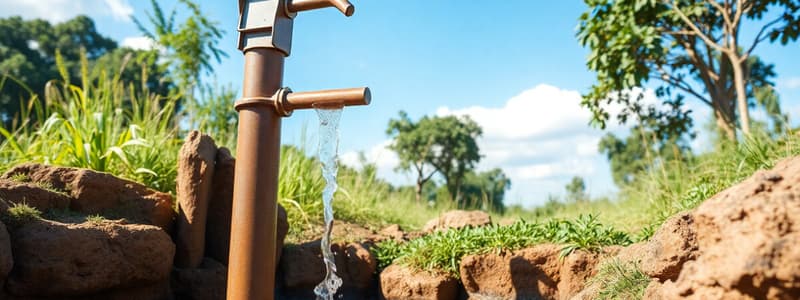Podcast
Questions and Answers
What was the primary purpose of the Canadian invention mentioned in the text?
What was the primary purpose of the Canadian invention mentioned in the text?
To bring clean drinking water to African villages.
Which of the following materials was used in the new hand pump design?
Which of the following materials was used in the new hand pump design?
- Iron
- Polyvinyl chloride (PVC) (correct)
- Copper
- Steel
The pump had to be durable enough to work continuously for _____ hours a day.
The pump had to be durable enough to work continuously for _____ hours a day.
18
The original pump designs were made from PVC.
The original pump designs were made from PVC.
How many pumps are being used in developing nations according to the text?
How many pumps are being used in developing nations according to the text?
What was one modification made to the pump in Sri Lanka?
What was one modification made to the pump in Sri Lanka?
What animal caused issues with the original white plastic spigots in Malawi?
What animal caused issues with the original white plastic spigots in Malawi?
What are the main sections covered in this unit?
What are the main sections covered in this unit?
Which of the following was a criterion for the new pump designed by Canadian scientists?
Which of the following was a criterion for the new pump designed by Canadian scientists?
The new pump is made from iron and steel.
The new pump is made from iron and steel.
What innovative material was used for the new pump's tubing?
What innovative material was used for the new pump's tubing?
How many pumps are currently used in developing nations?
How many pumps are currently used in developing nations?
In Sri Lanka, villagers decided to use a ______ washer instead of a plastic one.
In Sri Lanka, villagers decided to use a ______ washer instead of a plastic one.
What challenge in Malawi necessitated changing the material of the pump spigot?
What challenge in Malawi necessitated changing the material of the pump spigot?
Flashcards are hidden until you start studying
Study Notes
Canadian Invention Brings Water to African Villages
- Researchers from the University of Waterloo, Ontario, developed a low-cost, shallow-well pump for developing countries.
- The pump was designed to be durable, affordable, maintainable, and manufactured locally.
- The pump was inspired by a traditional hand-operated water pumps used by the Mennonite community in southern Ontario.
- The pump uses PVC tubing, which is inexpensive, readily available, and rust-resistant.
- Over 11,000 pumps are being used in 13 developing nations.
- The pump design can be adapted to local conditions. For example, in Sri Lanka, a leather washer is used instead of a plastic one, and in Malawi, the spigot is made of black metal to prevent hyenas from chewing it.
- This invention has brought clean drinking water to many villages in developing countries.
Using Science and Technology to Solve Problems
- Two Canadian scientists, Alan Plumtree and Alfred Rudin, invented a reliable hand-operated water pump in 1978.
- The pump's design met specific criteria for developing countries:
- Durable enough for 18 hours of continuous use.
- Affordable for people in poorer countries.
- Simple enough for villagers to maintain and repair.
- Designed for local manufacturing to create jobs and ensure the availability of spare parts.
- This exemplifies how science and technology can be used to solve real-world problems.
Canadian Invention Brings Water to African Villages
- Researchers at the University of Waterloo, Ontario developed a low-cost, shallow well pump that is easily used in developing countries.
- The invention was inspired by a hand-operated water pump used by a Mennonite community in southern Ontario.
- The pump was designed to be durable, affordable, simple to maintain and repair, and manufacturable in developing countries.
- The new pump incorporated polyvinyl chloride (PVC) tubing instead of traditional iron and steel.
- PVC is inexpensive, readily available worldwide, and rust-resistant.
- Over 11,000 pumps are being used in 13 developing nations.
- The pump design has been modified for local conditions, like using a leather washer in Sri Lanka and a black metal spigot in Malawi.
Using Science and Technology to Solve Problems
- Alan Plumtree and Alfred Rudin invented a reliable hand-operated water pump in 1978.
- The pump was designed to meet specific criteria for developing countries, including durability, affordability, simplicity, and local manufacturing.
Adapting the Technology
- The basic pump design can be modified for local conditions, like using a leather washer in Sri Lanka or a black metal spigot in Malawi.
- Modifications are made to suit the local resources and needs of the communities.
Studying That Suits You
Use AI to generate personalized quizzes and flashcards to suit your learning preferences.




